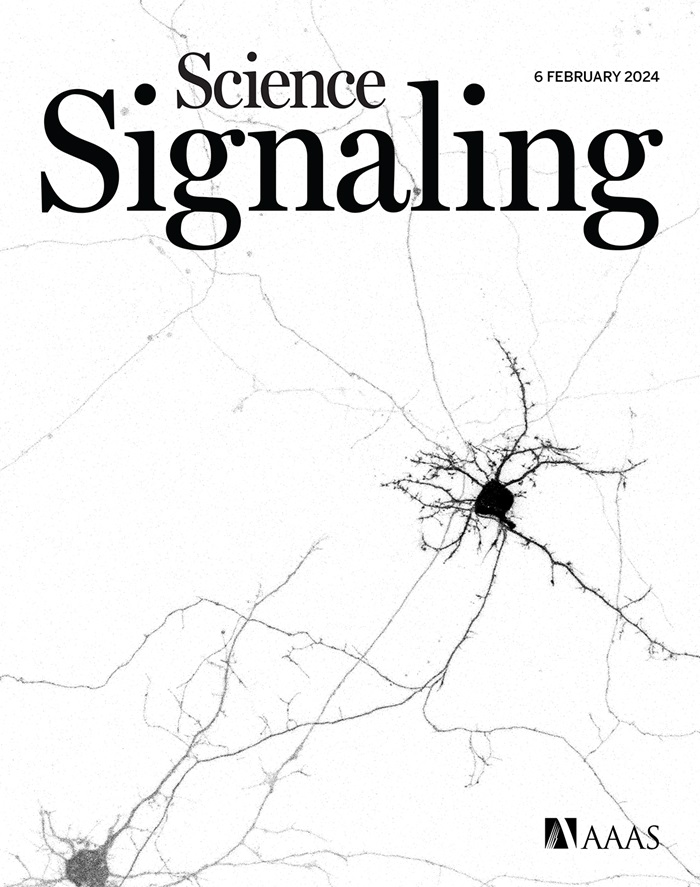PO-091:组胺受体1 (HRH1):一种潜在的新型G蛋白偶联受体(GPCR)治疗胰腺癌(PDAC)细胞和肿瘤的靶点
IF 7.3
1区 生物学
引用次数: 0
摘要
最近的一项研究报道,服用HRH1抗组胺药的患者可以减少各种肿瘤的进展,包括PDAC;作者推断这是一种免疫效应(Fritz et al., PMID: 33550204)。我们已经启动了一项研究来验证另一种假设:由PDAC细胞表达的HRH1可能导致恶性表型,如果是这样,fda批准的HRH1抗组胺药可能是治疗或预防PDAC的治疗药物。我们采用了生物信息学和实验方法来检验这一假设。我们的生物信息学分析显示,癌症基因组图谱(TCGA)中的PDAC肿瘤的HRH1表达量比正常胰腺(GTEx数据库)高30倍以上,并且在癌症细胞系百科全书(CCLE)中的PDAC细胞系中高表达。HRH1的表达选择性地与PDAC细胞的标记物相关,而与肿瘤微环境中其他细胞类型的标记物无关。HRH1在TCGA-PDAC肿瘤中的高表达会对患者的生存产生负面影响。我们的实验研究表明,人和小鼠PDAC细胞表达HRH1 mRNA、蛋白和信号,并且HRH1存在于PDAC细胞表面。我们发现组胺显著增加多种人类PDAC细胞系中的钙[Ca2+],其EC50值与其他细胞类型相当。组胺刺激的[Ca2+]增加通过Gq/11(异源三聚体GTP结合蛋白)依赖机制发生,并被多种fda批准的HRH1抗组胺药阻断(pKi值与其他细胞类型的HRH1抑制相似)。组胺激活HRH1增加PDAC细胞迁移。组胺还可以增加PDAC细胞中多种细胞因子(包括VEGF)的产生,在初步研究中,在低浓度(1-10 nM)下,组胺可以刺激多种PDAC细胞系的生长。结合已发表的数据表明,PDAC肿瘤中的肥大细胞(合成并释放组胺)与PDAC细胞的生长/侵袭、血管生成和更差的预后相关,我们的研究结果表明,独立于免疫细胞的“肥大细胞-组胺-PDAC细胞HRH1轴”可能有助于PDAC肿瘤的恶性表型。重要的是,通过重新利用已批准的HRH1抗组胺药作为PDAC肿瘤的新治疗方法,可以靶向PDAC细胞上的HRH1。由加州大学癌症研究协调委员会和烟草相关疾病研究项目资助。引文格式:Cristina Salmeron, Krishna Sriram, Mehrak Javadi-Paydar, Paul A. Insel。组胺受体1 (HRH1):一种潜在的新型G蛋白偶联受体(GPCR)治疗胰腺腺癌(PDAC)细胞和肿瘤的靶点[摘要]。摘自:AACR胰腺癌虚拟特别会议论文集;2021年9月29-30日。费城(PA): AACR;癌症杂志,2021;81(22增刊):摘要nr PO-091。本文章由计算机程序翻译,如有差异,请以英文原文为准。
Abstract PO-091: Histamine receptor 1 (HRH1): A potentially novel G protein-coupled receptor (GPCR) therapeutic target in pancreatic adenocarcinoma (PDAC) cells and tumors
A recent study reported that patients taking HRH1 antihistamines have decreased progression of various tumors, including PDAC; the authors inferred that this was an immune effect (Fritz et al., PMID: 33550204). We have initiated studies to test an alternative hypothesis: HRH1 expressed by PDAC cells may contribute to the malignant phenotype and if so, FDA-approved HRH1 antihistamines might be therapeutics to treat or perhaps prevent PDAC. We have undertaken bioinformatic and experimental approaches to test this hypothesis. Our bioinformatic analysis revealed that PDAC tumors in The Cancer Genome Atlas (TCGA) have >30-fold higher HRH1 expression than in normal pancreas (GTEx database) and is highly expressed in PDAC cell lines in the Cancer Cell Line Encyclopedia (CCLE). HRH1 expression was selectively associated with markers of PDAC cells and not with markers of other cell types in the tumor microenvironment. Higher expression of HRH1 in TCGA-PDAC tumors negatively impacts on patient survival. Our experimental studies indicate that human and mouse PDAC cells express HRH1 mRNA, protein and signaling and that HRH1 is present on the surface of PDAC cells. We found that histamine prominently increases calcium [Ca2+] in multiple human PDAC cell lines with EC50 values comparable to that in other cell types. The histamine-stimulated increase in [Ca2+] occurs via a Gq/11 (heterotrimeric GTP binding protein)-dependent mechanism and is blocked by multiple FDA-approved HRH1 antihistamines (with pKi values similar to those of HRH1 inhibition of other cell types). HRH1 activation by histamine increases PDAC cell migration. Histamine also increases the production of numerous cytokines (including VEGF) from PDAC cells, and in preliminary studies, stimulates growth of multiple PDAC cell lines at low concentrations (1-10 nM). Together with published data indicating that mast cells (which synthesize and release histamine) in PDAC tumors are associated with PDAC cell growth/invasion, angiogenesis and worse prognosis, our findings suggest that independent of immune cells, a "mast cell-histamine-PDAC cell HRH1 axis" may contribute to the malignant phenotype of PDAC tumors. Importantly, HRH1 on PDAC cells could be targeted by repurposing approved HRH1 antihistamines as a novel therapeutic approach for PDAC tumors. Supported by grants from the University of California Cancer Research Coordinating Committee and Tobacco-Related Disease Research Program. Citation Format: Cristina Salmeron, Krishna Sriram, Mehrak Javadi-Paydar, Paul A. Insel. Histamine receptor 1 (HRH1): A potentially novel G protein-coupled receptor (GPCR) therapeutic target in pancreatic adenocarcinoma (PDAC) cells and tumors [abstract]. In: Proceedings of the AACR Virtual Special Conference on Pancreatic Cancer; 2021 Sep 29-30. Philadelphia (PA): AACR; Cancer Res 2021;81(22 Suppl):Abstract nr PO-091.
求助全文
通过发布文献求助,成功后即可免费获取论文全文。
去求助
来源期刊

Science Signaling
Biochemistry, Genetics and Molecular Biology-Molecular Biology
自引率
0.00%
发文量
148
期刊介绍:
Science Signaling is a weekly, online multidisciplinary journal dedicated to the life sciences. Our editorial team's mission is to publish studies that elucidate the fundamental mechanisms underlying biological processes across various organisms. We prioritize research that offers novel insights into physiology, elucidates aberrant mechanisms leading to disease, identifies potential therapeutic targets and strategies, and characterizes the effects of drugs both in vitro and in vivo.
 求助内容:
求助内容: 应助结果提醒方式:
应助结果提醒方式:


